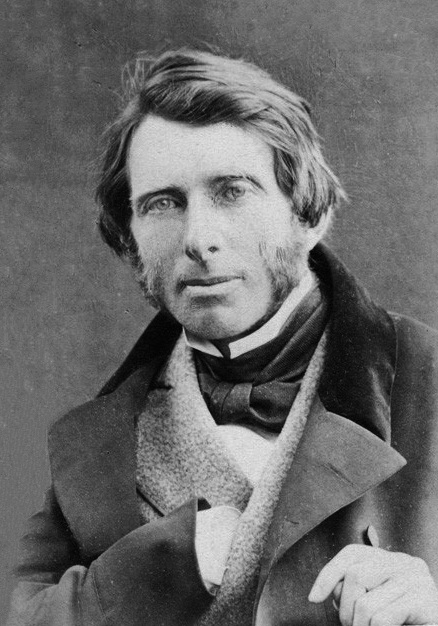To mark the 200th anniversary of the birth of the influential writer, thinker, artist and social reformer John Ruskin (1819 -1900), galleries, universities and cultural institutions across the world will celebrate his work, ideas and influence in a year-long programme of exhibitions, conferences and events.
John Ruskin was the leading English art critic of the Victorian era
Ruskin’s birthday on 8 February 2019 will be celebrated at the Royal Academy, London with: All Great Art Is Praise, readings from Ruskin by Michael Palin and Dan Draper, with settings by Sarah Rodgers of his words, and music performed by tenor Richard Edgar-Wilson and the Coull Quartet.

Ruskin’s talent as an artist and art critic will be celebrated in a series of exhibitions:
• Radical Victorianism: Progressive Achievements in the Age of Ruskin, Houghton Library, Harvard University, 1 Jan – 31 May
• John Ruskin: The Power of Seeing, 2 Temple Place, London, 26 Jan – 22 April
• Parabola of Pre-Raphaelitism: Turner, Ruskin, Rossetti, Morris and Burne-Jones, Mitsubishi Ichigokan Gallery, Tokyo, 23 Feb – 26 May, (then moving to Karume and Osaka, Japan)
• Turner, Ruskin and the Storm Cloud of the Modern World, York Art Gallery, York, 29 Mar – 23 June (then moving to Abbot Hall, Kendal, 11 July – 5 Oct).
• Incandescence: Turner’s Venice, Brantwood, Coniston 11 April – 4 August
• Treasure from Dust: Ruskin’s Geology, Brantwood, Coniston 8 August – 11 Nov
Ruskin’s ideas and values as a critic and social reformer will be explored in a series of international conferences:
• Mediating Ruskin: “Through a Kaleidoscope, Brightly”, Pau University, France, 8 – 9 February
• Ruskin and Scotland, Edinburgh University, 24 – 26 June
• Ruskin: Culture, Landscape and the Environment, Lancaster University, 27- 29 June
• Ruskin and Victorian Oxford, Christ Church, Oxford, 17 – 18 September
• Art for the Nation: John Ruskin, Art Education and Social Change, National Gallery, London, 20 – 21 September
• “A great community”: John Ruskin’s Europe, Ca’ Foscari University, Venice, 7-9 October.
• John Ruskin: 19th Century Visionary, 21st Century Inspiration, Huntington Library, San Marino, California, 12 -14 December
Publications marking Ruskin’s bicentenary include Robert Hewison, Ruskin and his Contemporaries, Suzanne Fagence Cooper, The Ruskin Renaissance, 1969-2019, Andrew Hill, Ruskinland, Kevin Jackson, The Worlds of John Ruskin, Jim Spates, Why Ruskin?, Suzanne Fagence Cooper, To See Clearly: Why Ruskin Matters.
A choral evensong will be held in celebration of Ruskin’s life and work at St George’s, Bloomsbury, on 15 February.
John Ruskin (8 February 1819 – 20 January 1900) was the leading English art critic of the Victorian era, as well as an art patron, draughtsman, watercolourist, a prominent social thinker and philanthropist. He wrote on subjects as varied as geology, architecture, myth, ornithology, literature, education, botany and political economy.
His writing styles and literary forms were equally varied. He penned essays and treatises, poetry and lectures, travel guides and manuals, letters and even a fairy tale. He also made detailed sketches and paintings of rocks, plants, birds, landscapes, and architectural structures and ornamentation.
The elaborate style that characterised his earliest writing on art gave way in time to plainer language designed to communicate his ideas more effectively. In all of his writing, he emphasised the connections between nature, art and society.
He was hugely influential in the latter half of the 19th century and up to the First World War. After a period of relative decline, his reputation has steadily improved since the 1960s with the publication of numerous academic studies of his work. Today, his ideas and concerns are widely recognised as having anticipated interest in environmentalism, sustainability and craft.
Ruskin first came to widespread attention with the first volume of Modern Painters (1843), an extended essay in defence of the work of J. M. W. Turner in which he argued that the principal role of the artist is “truth to nature”. From the 1850s, he championed the Pre-Raphaelites who were influenced by his ideas. His work increasingly focused on social and political issues. Unto This Last (1860, 1862) marked the shift in emphasis. In 1869, Ruskin became the first Slade Professor of Fine Art at the University of Oxford, where he established the Ruskin School of Drawing. In 1871, he began his monthly “letters to the workmen and labourers of Great Britain”, published under the title Fors Clavigera (1871–1884). In the course of this complex and deeply personal work, Ruskin developed the principles underlying his ideal society. As a result, he founded the Guild of St George, an organisation that endures today. – From Wikipedia

